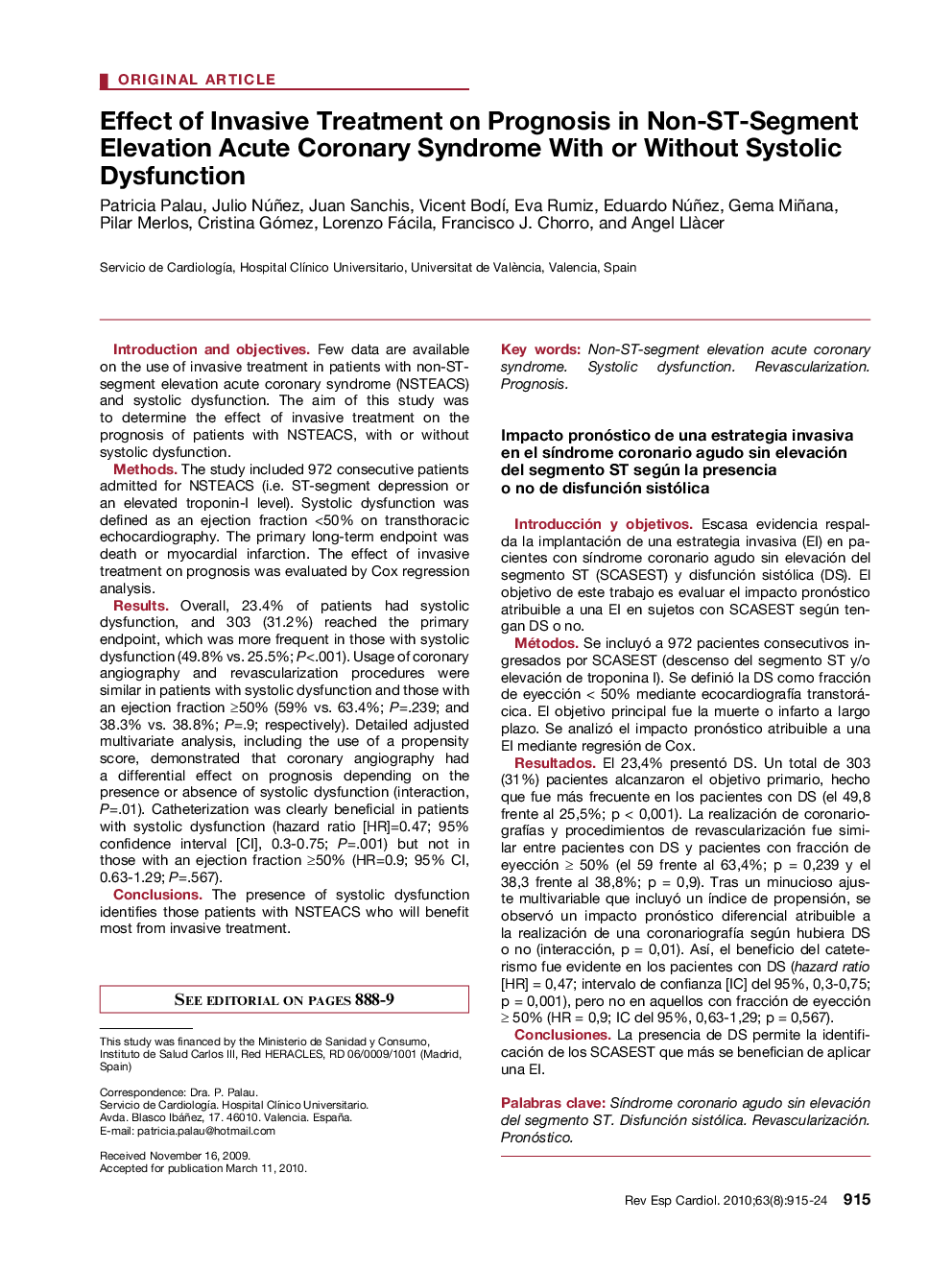| Article ID | Journal | Published Year | Pages | File Type |
|---|---|---|---|---|
| 3018526 | Revista Española de Cardiología (English Edition) | 2010 | 10 Pages |
Introduction and objectivesFew data are available on the use of invasive treatment in patients with non-STsegment elevation acute coronary syndrome (NSTEACS) and systolic dysfunction. The aim of this study was to determine the effect of invasive treatment on the prognosis of patients with NSTEACS, with or without systolic dysfunction.MethodsThe study included 972 consecutive patients admitted for NSTEACS (i.e. ST-segment depression or an elevated troponin-I level). Systolic dysfunction was defined as an ejection fraction <50% on transthoracic echocardiography. The primary long-term endpoint was death or myocardial infarction. The effect of invasive treatment on prognosis was evaluated by Cox regression analysis.ResultsOverall, 23.4% of patients had systolic dysfunction, and 303 (31.2%) reached the primary endpoint, which was more frequent in those with systolic dysfunction (49.8% vs. 25.5%; P<.001). Usage of coronary angiography and revascularization procedures were similar in patients with systolic dysfunction and those with an ejection fraction ≥50% (59% vs. 63.4%; P=.239; and 38.3% vs. 38.8%; P=.9; respectively). Detailed adjusted multivariate analysis, including the use of a propensity score, demonstrated that coronary angiography had a differential effect on prognosis depending on the presence or absence of systolic dysfunction (interaction, P=.01). Catheterization was clearly beneficial in patients with systolic dysfunction (hazard ratio [HR]=0.47; 95% confidence interval [CI], 0.3-0.75; P=.001) but not in those with an ejection fraction ≥50% (HR=0.9; 95% CI, 0.63-1.29; P=.567).ConclusionsThe presence of systolic dysfunction identifies those patients with NSTEACS who will benefit most from invasive treatment.
Introducción y objetivosEscasa evidencia respalda la implantación de una estrategia invasiva (EI) en pacientes con síndrome coronario agudo sin elevación del segmento ST (SCASEST) y disfunción sistólica (DS). El objetivo de este trabajo es evaluar el impacto pronóstico atribuible a una EI en sujetos con SCASEST según tengan DS o no.MétodosSe incluyó a 972 pacientes consecutivos ingresados por SCASEST (descenso del segmento ST y/o elevación de troponina I). Se definió la DS como fracción de eyección < 50% mediante ecocardiografía transtorácica. El objetivo principal fue la muerte o infarto a largo plazo. Se analizó el impacto pronóstico atribuible a una EI mediante regresión de Cox.ResultadosEl 23,4% presentó DS. Un total de 303 (31%) pacientes alcanzaron el objetivo primario, hecho que fue más frecuente en los pacientes con DS (el 49,8 frente al 25,5%; p < 0,001). La realización de coronariografías y procedimientos de revascularización fue similar entre pacientes con DS y pacientes con fracción de eyección ≥ 50% (el 59 frente al 63,4%; p = 0,239 y el 38,3 frente al 38,8%; p = 0,9). Tras un minucioso ajuste multivariable que incluyó un índice de propensión, se observó un impacto pronóstico diferencial atribuible a la realización de una coronariografía según hubiera DS o no (interacción, p = 0,01). Así, el beneficio del cateterismo fue evidente en los pacientes con DS (hazard ratio [HR] = 0,47; intervalo de confianza [IC] del 95%, 0,3-0,75; p = 0,001), pero no en aquellos con fracción de eyección ≥ 50% (HR = 0,9; IC del 95%, 0,63-1,29; p = 0,567).ConclusionesLa presencia de DS permite la identificación de los SCASEST que más se benefician de aplicar una EI.
